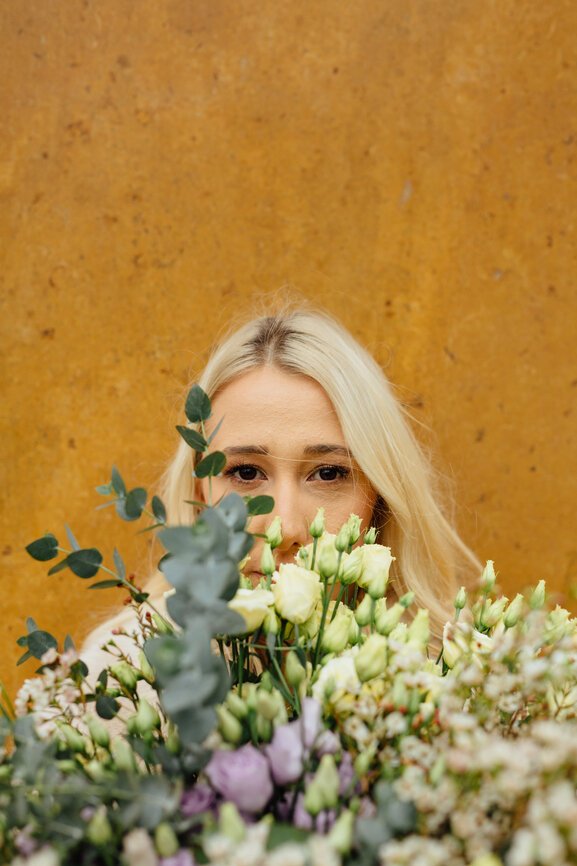
Can A Comfort Object Help You Get Better Sleep? It Does For Me
My first best friend was made of pastel technicolor yarn. She was a blanket—affectionately called Blankie—and was a staple in every aspect of my childhood. Crocheted for me when I was a newborn by my grandmother, she was my shell-stitched sleep companion. Whether she was misplaced or tumbling in the dryer, I wouldn’t (and couldn’t) go to bed without my hand and face touching the familiar texture.
But my blanket meant so much more than that. Blankie transformed into everything from a cape to a carryall for my Beanie Babies, an early outlet for my imagination and creativity. She offered shade from the sun on road trips and bundled me up after bathtime. She accompanied me to sleepovers with my friends, who accepted her without question or judgment, even into my teenage years. When I was scared of the dark, or lonely, or sad—Blankie was there. As an often insecure child, my blanket stitched up the space between my feelings of “outsiderness” and a world that was ready to welcome me and wrap me in its arms.
“My blanket stitched up the space between my feelings of ‘outsiderness’ and a world that was ready to welcome me and wrap me in its arms.”
When I moved away to college, she was the last thing I packed, folding her carefully on top of whatever junk I deemed worthy of my emerging life. Most of that other stuff has long been forgotten, but not Blankie. She was a treasure among trash.
I share all this because I don’t think it’s an uncommon experience. In fact, I know it’s not. Turns out, many adults don’t transition out of these “transitional objects.” These are the first “not-me” items we perceive in our early childhood years, and they help us establish independence from our mothers because, fun fact, infants believe they are the same being as their mother for the first several months.
Additionally, transitional objects serve as “a neutral sphere in which experience is not challenged.” They offer a non-judgmental space for us as children to feel our feelings without consequence. These objects are often one of our first possessions, and they become the first sign that we are, in fact, individuals. In supporting that individuality, transitional objects are the first tools we have to learn how to self-soothe—an essential skill in our development.
“Transitional objects are the first tools we have to learn how to self-soothe—an essential skill in our development.”
This self-soothing is also useful as an adult, especially for neurodivergent folks, when the world feels increasingly unpredictable. If, at the end of the day, a routine where you bury your face into a familiar texture feels grounding and invites rest, then it is a good one. Similar to weighted blankets and anxiety rings, finding an object that re-connects you to your body (versus a racing mind) can help lower your stress and increase your presence. In fact, I often hold a blanket in my hands when I meditate to keep me present in my senses and the moment.
All of these mindfulness tools can be helpful when we’re trying to establish a healthy sleep routine, and can contribute to higher quality sleep. Looking back at my Blankie after all these years, I realize I was planting the seeds of self-regulation and awareness that I’m still watering and nurturing to this day.
Despite what long meetings and LinkedIn profiles try to tell us, we don’t simply lose our need for comfort in adulthood. It just shows up differently for each of us. Maybe for you, it’s an Ingrid Michaelson album, an old worn t-shirt from high school, a box fan for white noise, or a box of Kroger-brand mac and cheese. These comfort items and soothing sensory experiences don’t have to remain hidden in our past, in our closets, or in our pantries. They don’t need to be belittled or explained away, either.
Especially if they support healthier routines or help us find better sleep. Comfort objects can help return us to ourselves after each day of sharing ourselves with the world.
“If you still find comfort in a blankie, a lovie, or a teddy, know that you aren’t alone.”
These days, Blankie remains folded by my bedside. Her once-fluffy rainbow yarn has dwindled into threads, and I’m scared that if I keep snuggling—and washing—her, there will be no more blanket left to love. But to preserve Blankie’s legacy of comfort (and to preserve the quality of my sleep), I’ve crocheted a new blanket that I sleep with every night. If I ever find myself traveling without the familiar texture of a crocheted blanket, I even try to pack a sweater or find a small stuffed animal that can serve as a stand-in. It’s a non-negotiable ritual for my sleep, and that’s what works for me.
If you still find comfort in a blankie, a lovie, or a teddy, know that you aren’t alone. Take it from me, you should not have to sacrifice the tools that help you sleep better because you’re worried about what other people think. Don’t silo yourself in shame—because whatever it is that keeps you going, I celebrate it.
And you can bet that even when I’m old and gray, I’ll be crocheting blankies for the new generation, offering them up as a supportive item for their own slumber and self-realization.
Then, I’ll go to sleep soundly with my own.
Emily Torres is the Editorial Director at The Good Trade. Born and raised in Indiana, she studied Creative Writing and Business at Indiana University. You can usually find her in her colorful Los Angeles apartment journaling, caring for her rabbits and her cat, or gaming.





